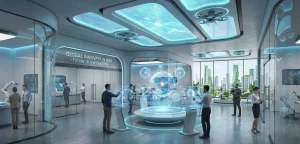Future of Work: Evolving Office Post-Pandemic
Published on
The office has evolved in form and function over the centuries; from hierarchical clusters and cubicle labyrinths to aesthetically pleasing open plan design, collaboration spaces and hot desking. However, COVID-19 has triggered a more fundamental shift in its role – going beyond providing physical infrastructure for business functions, to enabling business success.
Having endured more than a two years of remote work and accelerated technology adoption, companies and employees have accepted that the future of work involves flexibility and hybrid work. However, the office is here to stay and depending on the strategic imperatives of each organization, the workspace will be a driver of cost resilience, a strategic asset or a catalyst for growth.
Cost Resilience, Thriving through uncertainty
As uncertainty pervades the new normal, organizations are embracing an agile approach to navigate the business environment, which has been fluctuating between caution and enthusiasm. To reduce costs and protect margins, most organisations are re-evaluating their real estate needs and reducing unutilised capacity for a future entailing hybrid work. Companies are also looking at ways to move away from long-term commitments in real estate to flexible workspace solutions that do not involve upfront capital investment, ability to scale with changes in their business plans and eliminate the operational challenges of building and managing facilities.
COVID-19 has also created some interesting challenges and opportunities for workspace design, which companies can utilize to their advantage. The future of work will require fluid work environments, where spaces are designed for possibilities, instead of defined identities. With flexibility being the common denominator, workspaces will be designed to achieve more output with less real estate, more efficient capacity modelling based on scheduled utilisation and more adaptability to changes in business needs and disruption. Looking beyond the pandemic, architecture, automation, immersive augmented reality, IoT and artificial intelligence will allow companies to optimise operational costs through real time data analytics of energy and water consumption, adaptable lighting and temperature control as well as environmental monitoring for functionality and sustainability. Slowly but surely, the workspace is evolving from being a static expense to a versatile resource that delivers more for less.
Tangible and Intangible ROI of Workspace as an Asset
There is a paradox in the way workspaces are utilized and accounted for. While the new accounting rules recognize leases as a liability, very few organisations measure the ROI of workspaces in terms of impact on productivity, talent retention and brand-building. Data on corporate real estate is more than numbers on a spreadsheet. They are stories of people and their engagement with spaces where company culture and purpose are physically experienced – the souls behind the numbers. For every data point on ratio of collaboration spaces to workstations, there is a story of an agile team that undertakes remote remodeling of hundreds of retail stores in the US. For every dollar spent on height-adjustable desks, there is a story of a data scientist who spends several hours a day clustering and testing new algorithms to allow the supply chain to set new benchmarks of order fulfilment.
In the new normal, people will come to office to collaborate, build social capital and feel connected to the organisation they work for. The workspace will foster trust, alignment with corporate culture, innovation and inclusion — these are human imperatives linked to successful business outcomes. The conversation about workspace investment is no longer about saving money, but strategic investment in design, infrastructure and technology that has measurable business impact. The most successful companies will leverage the design and experiential elements of the built environment and workplace services to provide an aspirational ecosystem, that elevates the output over remote work and enhances the organisation’s ability to attract and retain their most important resource – talent.
Catalyst for Change, Innovation and Growth
According to Microsoft, if 2020 was the year of the Chief Technology Officer, then 2021 will be the year of the Chief Human Resources Officer (CHRO). Besides dealing with employee safety and wellbeing over the past several months, CHROs have been busy reimagining hiring, cultural alignment and employee engagement for a remote workforce. In the war for talent, the workspace is not just a differentiator, but a catalyst for facilitating human interaction in both physical and digital environments, which cannot be replicated at home or in any other setting.
In a world that has been forced into isolation, people need opportunities for collaboration, communication and recognition that the workspace provides. New experiences, choice of spaces and a digital-first built environment will create opportunities for discovery, creativity, innovation, problem-solving and organic growth. Organisations who reimagine the workspace as a competitive advantage will change perception, manifest their brand identity, influence customer behaviour and inspire others to follow their lead.
The past year has challenged the existence of the office and demonstrated the ability of the world to function without one. Yet, it has demonstrated remarkable resilience as an asset class, with investments of over $3Bn in India in 2020. The office will always exist, but mean different things to different organisations. However, its true value is measured by the people who work there and the impact they have on organizational goals. While some organisations will return to office as usual, certain others will fast forward to reimagining its purpose and business impact. If your organization falls in the latter category, welcome back to the future of work!




